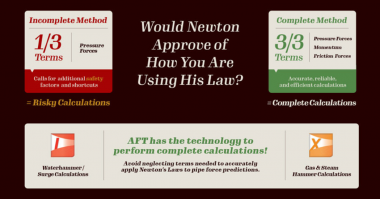Author: Dylan Witte, Applied Flow Technology
Computers currently cannot think like an engineer. That is probably a good thing, but sometimes it can get us in trouble. Many of us rely on computers daily not just for fun or leisure, but for our livelihoods. They connect us in ways previous generations never thought possible and augment our mental abilities especially in terms of performing complex calculations and modeling intricate systems. Knowing this, it is important to remember that no matter how slick the user interface or how advanced the underlying code is, a computer program is only going to take what you give and process it with cold, unthinking logic.
It is all too easy to place confidence on the results of an analysis simply because it has been run through a computer. The numbers and results know nothing about a real system. This highlights the importance of good data and the understanding of the engineering assumptions behind any modeling software.
In the context of fluid flow analysis this is especially important. While fluid flow software uses some laws of physics such as conservation of mass-energy and conservation of momentum, there is no “law of frictional losses in a pipe”. Rather than a single law there are a myriad of methods used for estimating frictional losses based on empirical data. Each method is the closest approximation of what has been measured in specific and ideal situations. Without understanding the underlying premises for each model and how they use the data provided, it can be easy to fill it with garbage values and have garbage results spat back out.
Obviously, this is a situation any engineer worth one’s their salt needs to avoid. This appears simple enough on the surface, just use better data and know your fluid mechanics, but it becomes a little more complex when much of the data is unknown or uncertain.
Assumptions must be made in these situations and documenting them becomes paramount. It is all too easy to fall into the trap of treating results as a certainty when writing a report. But what assumptions can be safely made and what data is truly important and should not be assumed?
Typically, engineers will choose the conservative option. We will assume more pressure drop and higher flows. Is this always the best option? No; especially when sizing centrifugal pumps. Pumps are designed for a specific range of operation and the further away they are from their operating point, the greater the concerns for vibration and cavitation within the pump. It is best to choose the assumption closest to reality. Applying a safety factor to input data rather than the output data can have unintended consequences as the safety factor is carried through several layers of non-linear calculations.
My experience has shown the most important input data to have accurate data on for a hydraulic analysis is:
- Hydraulic Diameter. This is especially important for older systems that may have experienced corrosion and build-up. A change in diameter not only changes velocity, but also alters the overall resistance to flow in a pipe.
- Fluid Properties. This may seem obvious, but a slight change in viscosity or density will alter pressures throughout the system. This is especially true for transient analysis where a change in fluid bulk modulus – the measure of a fluid’s resistance to compression - can change wavespeed (celerity) and therefore all predicted transient pressures. Also, a change in vapor pressure can be the difference between large scale system wide transient cavitation and business as usual.
- Valve and Pump Transients. Specific data such as pump inertia and valve closure profiles are especially tricky; not only are they often the most difficult data to obtain, but they are also the most impactful on results. Not only does the duration of a transient change results, but typically valve closures and pump transients are not linear events.
What should be done when some or most of this data is unavailable?
The input data that can generally be neglected is:
- Small components. Objects such as elbows and non-acting valves can typically be ignored if the overall length of pipe is much more significant (i.e. pipelines or transmission mains). There is a reason they are called minor losses. Often, they can be lumped together if the location of the pressure loss is not important. This is less true for smaller diameter piping or shorter systems where components can make up the bulk of pressure drop.
- Elevation Details. Generally, the most important elevations that need to be known are your boundaries. Hydrostatic pressure changes with elevation, but flow rates will typically not vary due to intermediate elevations. The two exceptions for which more detailed elevation data should be used are when system pressures are near vapor pressure or a maximum design pressure for the piping. In these cases, a high point could be a likely point of vapor formation and a low point could over-pressurize the piping.
This is certainly not a comprehensive list, but rather what I have seen as being impactful on fluid analysis. This varies depending on industry and expected margins of error. Leave a comment on what you think is important or what can be neglected.
See More from Applied Flow Technology!
About the Author
As a PMTG Consulting Engineer, Dylan works over a wide range of industries providing hydraulic modeling expertise, risk analysis, and quotes and perspectives. He is currently pursuing licensure as a Professional Engineer in the state of Colorado and holds a Bachelor's of Science in Mechanical Engineering (2014) from Colorado School of Mines. Read more from Dylan.





Comments